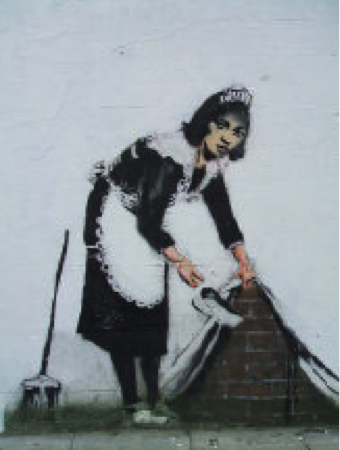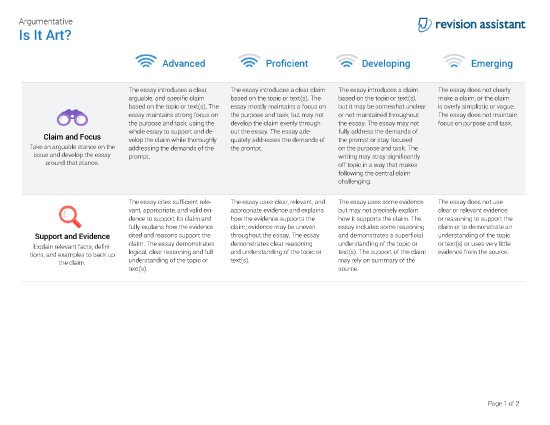Grade 6 | Argumentative | Source-Based
Source Lexile®: 1160L-1230L | Learning Standards
Prompt
Is graffiti art or vandalism? The city of Covina is preparing to write a position statement on whether graffiti is an art form, or whether it is vandalism. The mayor has invited the public to join in the debate before the city writes its position statement.
After reading the provided articles and viewing the video on the topic, write an argumentative, multi-paragraph essay that addresses the question “Is graffiti art or vandalism?” You must support your position with evidence from the texts and video.
Source 1
“Is Graffiti Art?”
By Steve Dolan
You can travel almost anywhere in the world, and you will probably see graffiti. Although graffiti art is usually more common in big cities, the reality is that it can occur in almost any community, big or small.
The problem with graffiti art is the question of whether it's really art, or just plain vandalism. This isn't always an easy question to answer, simply because there are so many different types of graffiti. Some is simply a monochrome collection of letters, known as a tag, with little artistic merit. Because it's quick to produce and small, it is one of the most widespread and prevalent forms of graffiti.
Although tagging is the most common type of graffiti, there are bigger, more accomplished examples that appear on larger spaces, such as walls. These are often multicolored and complex in design, and so start to push the boundary of whether they should really be defined as graffiti art.
If it wasn't for the fact that most graffiti is placed on private property without the owner's permission, then it might be more recognized as a legitimate form of art. Most graffiti art, however, is only an annoyance to the property owner, who is more likely to paint over it or remove it than applaud its artistic merit.
Many solutions have been put into practice around the world, with varying degrees of success. Paints have been developed that basically cause graffiti paint to dissolve when applied, or else make it quick and easy to remove. Community groups and government departments coordinate graffiti removal teams.
In some places you can't buy spray paint unless you're over 18. Cans of spray paint are locked away in display cases. In a nearby area the local council employs someone to go around and repaint any fences defaced by graffiti. A friend of mine has had his fence repainted 7 times at least, and it took him a while to find out why it was happening! Certainly the amount of graffiti in my local area has dropped substantially in the last year or two, so it appears these methods are working to a great extent.
But is removing the graffiti doing a disservice to the artistic community? Maybe if some of the people behind the graffiti art were taken in hand and trained, they could use their artistic skills in more productive ways. It hardly makes sense to encourage these artists to deface public property, and so commit a crime. But perhaps there are other ways to cooperate with the graffiti artists rather than just opposing them. Graffiti artists can create sanctioned murals for private property owners and get paid for it.
Maybe we need to start at a very basic level and find a way to encourage the creation of graffiti art on paper or canvas, rather than walls. After all, who would remember Monet or Picasso if they'd created their masterpieces on walls, only to have them painted over the next day? Finding a solution to such a complex situation is never going to be easy, but as more graffiti art is being recognized in galleries around the world, we do need to try.
Source 2
"Graffiti: Art or Vandalism?" (Video)
https://www.youtube.com/watch?v=k2Eu2na_diY&safe=active
Source 3
"Graffiti as Art"
Any passerby in an urban cityscape has observed the colorful, provocative, illegal "eyesore" that is graffiti. Although many consider the spray-painted pieces a nuisance, graffiti has been gaining recognition from the art world more and more as a legitimate form of art.
When most people think of graffiti, they imagine "tags," or a stylized writing of a person's name. While tags are probably the most popular forms, graffiti art is much more than that. It can mean a colorful mural with a message of diversity or a black and white stencil piece protesting police brutality. In each case, graffiti art makes a statement.
Aesthetics
George C. Stowers wrote that based on aesthetic criteria, graffiti has to be considered an art form. He makes a distinction between simple tags and more complicated pieces, stating that tags have little aesthetic appeal and probably should not be considered art.  However, larger pieces require planning and imagination and contain artistic elements like color and composition. Stowers provides the example of wildstyle, or the calligraphic writing style of interlocking letters typical of graffiti, to show the extent of artistic elements that are present in these works.
However, larger pieces require planning and imagination and contain artistic elements like color and composition. Stowers provides the example of wildstyle, or the calligraphic writing style of interlocking letters typical of graffiti, to show the extent of artistic elements that are present in these works.
"Wildstyle changes with each artist's interpretation of the alphabet, but it also relies on the use of primary colors, fading, foreground and background, and the like to create these letters," he writes. The artist's intention is to produce a work of art, and that must be taken into account when considering street art's legitimacy.
Stowers explains that graffiti cannot be disregarded because of its location and illegality. The manner in which graffiti art is executed is the only obstacle it faces in being considered an art form.
A Nod from the Art Crowd
People are used to seeing graffiti art in public spaces, after all, that's what makes it graffiti. However, after years of gaining recognition by the art community, graffiti art has been shown in various galleries in New York and London,  and artists are often commissioned to do legal murals and other work for art shows.
and artists are often commissioned to do legal murals and other work for art shows.
One of the most famous graffiti artists, Banksy, has had his work shown in galleries such as Sotheby's in London. Despite his anonymity, the British artist has gained tremendous popularity. Celebrities such as Angelina Jolie and Brad Pitt have purchased his work for a hefty price.
Recognition by the art world and inclusion in galleries and auctions is one way that graffiti art is legitimized as "real" art. In addition, this exposure has helped the graffiti movement to become launched into the rest of the world.
A Style All Its Own
Like all other artistic forms, graffiti has experienced movements or changes in style. From the first tag scribbled on a subway train to the large, complex mural on a billboard, the movement has experienced change. The tools and the means have changed as well. Markers were traded in for spray paint, and stencils and stickers were introduced to make pieces easier to execute in a hurry.
The messages have also evolved. Graffiti has always been somewhat political, but it has come a long way from simply tagging one's name to parodying world leaders to make a statement.
This is further proof that graffiti is a form of art and not just a result of random acts of vandalism. The graffiti community moves in different directions and the resultant artwork moves with it.
Source 4
"Graffiti as Vandalism"
Although its artistic merits can't be denied, graffiti is still in fact a form of vandalism. Artists tag both public and private property, which becomes costly for taxpayers and business and property owners.
Costs
The cost for cleanup in the U.S. has not been documented definitively, but it is safe to assume that it is in the billions of dollars. Large cities typically budget more money toward graffiti removal. In 2006, Chicago budgeted $6.5 million while Omaha, Nebraska spends about $100,000 annually, according to graffitihurts.org.
In addition to cleanup costs, graffiti vandals often shoplift their materials, according to the U.S. Department of Justice. Stealing spray paint and markers adds an additional cost to businesses.
Vandalism also affects revenue from transportation, as evidenced by the reduction in riders during the 1960s and 1970s. Even before graffiti became associated with gangs, people became afraid of riding the vandalized subways.
Crime
Graffiti sometimes has a wave effect, in which a heavily vandalized area will experience increases in other sorts of crimes as well. Gang-related crimes and violence are the crimes most commonly associated with graffiti.
Public disorder crimes, such as littering and loitering and other forms of property destruction are sometimes related to graffiti crimes. Because most taggers are males between 15 and 23, there is the concern that tagging may be a "gateway crime," and may lead young offenders to more serious or dangerous crimes such as truancy and drug and alcohol use.
Quality of Life
Vandalism is usually seen as a quality of life issue. When an area has extensive graffiti, people tend to view it as a "bad neighborhood." Nearby property value may decrease and crime may increase. Plus, residents see graffiti as an eyesore. Graffiti that is gang-related or expresses hateful sentiments is most likely to be unwelcome in an area.
Rubric

 This work is licensed under a Creative Commons Attribution-NonCommercial 4.0 International License.
This work is licensed under a Creative Commons Attribution-NonCommercial 4.0 International License.